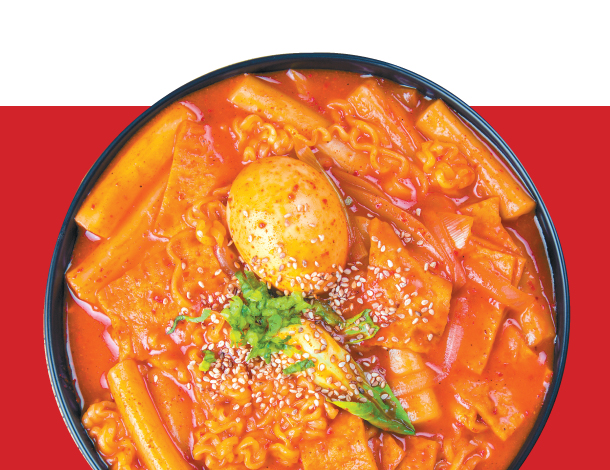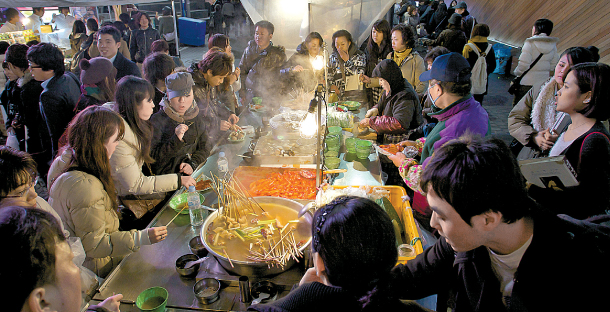[ICONIC FOOD] A nostalgic snack with a spicy kick : Known as Korean ‘soul food,’ tteokbokki can be enjoyed any time of day

Often called the “soul food” of Korea, most people have one or two go-to tteokbokki places they go whenever they have cravings. The literal translation of tteokbokki is stir-fried tteok, revealing its simple recipe. All you need to do is add gochujang to a sugary water mixture, and then add the tteok once the spicy water starts to boil. You can add other vegetables such as daepa, similar to leek, as well as fish cake and sometimes even ramyeon noodles.
There are two distinct styles of tteokbokki, depending on which ingredient is used to make the tteok - either rice or flour. Those who love sauce slathered all over the tteok go for miltteok, made with flour, and those who like stickier textures go for ssaltteok, made with rice.
The first question tteokbokki fans often ask one another is what their favorite style of tteok is, in order to choose which spot is best for their tastes.

Top: People gather around the outdoor food stalls in Myeong-dong, central Seoul, which serve tteokbokki and more.
Usually, people develop their tteokbokki preference during middle or high school. There are often street food booths located near schools in residential districts that get crowded after school with students looking to fill up with snacks before heading home or to other activities. Tteokbokki is also cheap, making it a popular choice for students who don’t have much money in their wallets. One serving is usually between 2,000 ($1.77) and 3,000 won.
The daytime snack also goes well as a late night treat. Many tteokbokki places in busy areas such as Apgujeong-dong, southern Seoul, only pop up after dark to cater to those looking to get some food after a drink or two, or a long day at work. Even upscale whisky bar The Booze in Cheongdam-dong, southern Seoul, offers a bowl of tteokbokki at night.
Some speculate that the version of tteokbokki that is known and loved today, came to be in the 1950s when a merchant named Ma Bok-rim started to sell it on the streets of Sindang-dong, central Seoul. It is said the style she sold was made with a sauce that was a mix of gochujang and chunjang, a black sauce used to make jjajangmyeon, or Korean-Chinese black noodles. Similar recipes spread to other shops in the area, and Sindang-dong became branded as the neighborhood to visit for tteokbokki fans in the 1970s.

Above: There are many different types of tteokbokki outside the version that is covered in spicy gochujang sauce. On the left is a version made with a mixture of gochujang and chunjang, the black sauce used to make jjajangmyeon, the Korean-Chinese dish, while the dish on the right is made with soy sauce, beef and a variety of vegetables, similar to the style enjoyed during the Joseon era (1392-1910). SHUTTERSTOCK]
These days, many are getting more creative than ever in order to make tteokbokki that suits their taste buds. Many restaurants offer different versions of the dish - some add all kinds of cheese while others add only jjajang sauce, without the spicy sauce. Some even sprinkle small fried shrimp onto the top of the dish to make it crispier. Other restaurant franchises have made a business of offering different levels of spice to challenge those who love spicy food, and add extra pepper to bring it to a level where one’s mouth can burn and become numb.
While tteokbokki, despite its relatively short history, has become one of the go-to snacks for Koreans, one local food critic in January argued on TV that tteokbokki is not a “tasty” food. He pointed out that society has made it difficult for people to publicly admit that they don’t like ttokbokki, and that people are subconsciously forced to like the dish.
“Would people show this much discomfort if [I] had said any other food is not tasty?” he said on social media after his comment instantly created controversy. He added that the Lee Myung-bak administration (2008-2013) was behind the scheme to make the snack something that everyone should like. “I wonder if the idea that ‘Koreans should think tteokbokki is good’ was really made voluntarily or was forced by someone else.”
His argument quickly failed to earn much support especially after people became aware of the fact that Hwang had appeared in a commercial for a tteobokki franchise. Hwang explained that he was just letting the company use his name because he was told that some of the revenue would go to help out children in need, and said that it was his right to decide what kinds of commercials he appeared in.
Lee Sun-min
[summerlee@joongang.co.kr]










with the Korea JoongAng Daily
To write comments, please log in to one of the accounts.
Standards Board Policy (0/250자)